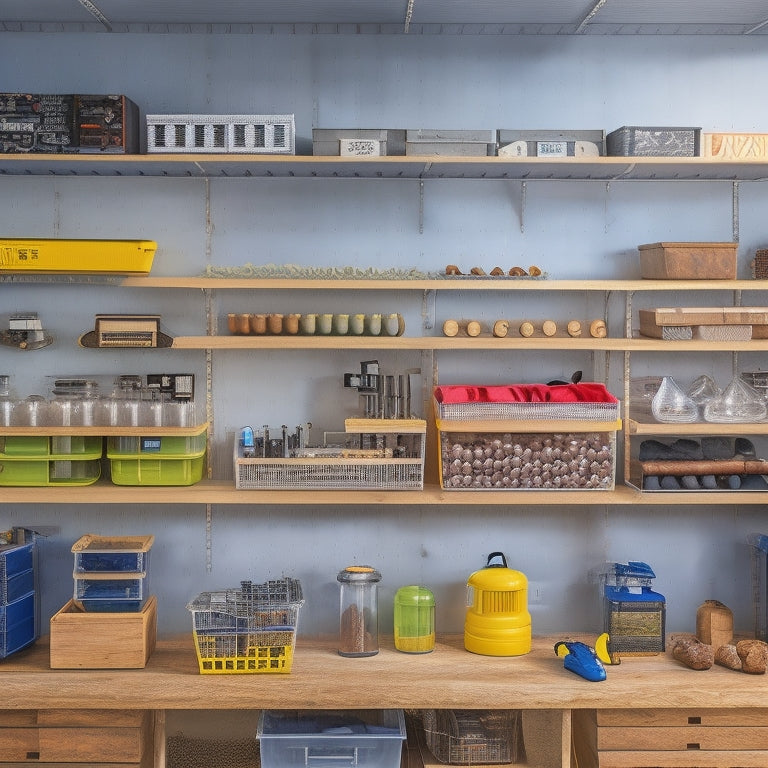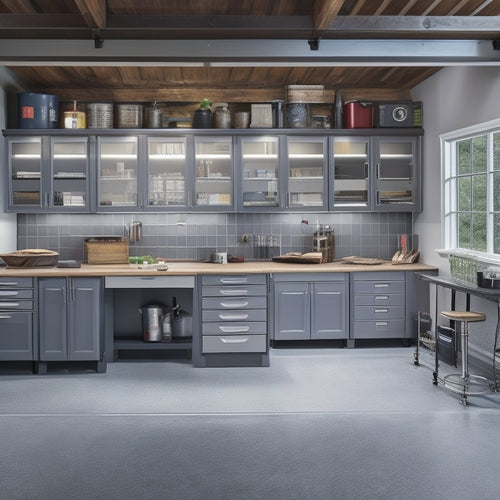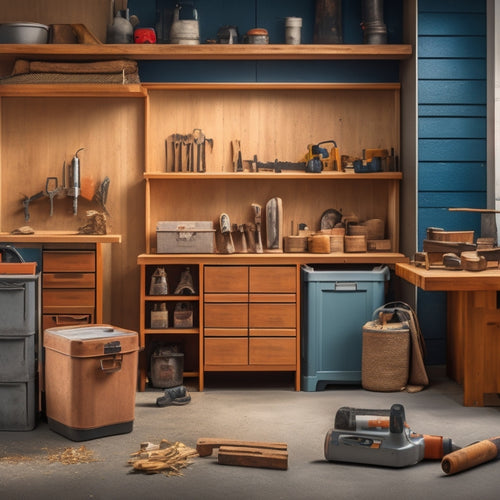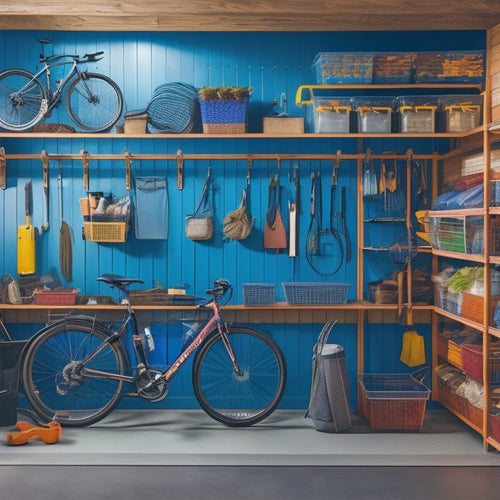
Small Parts Organizers for Maximum Storage Efficiency
Share
You can change your workspace into a haven of efficiency by utilizing small parts organizers, which declutter your area, reduce search time, and minimize accidents. With a wide range of storage containers available, from plastic bins to modular systems, you can choose the perfect fit for your inventory. Make sure you select the right size by measuring your space and considering item frequency. By maximizing vertical storage, labeling, and categorizing your parts, you'll be well on your way to achieving maximum storage efficiency. Now, uncover how to customize your solution to fit your unique needs and reveal the full potential of your workspace.
Key Takeaways
- Choose the right organizer size by inventorying items, measuring space, and assessing access frequency to optimize compartment design and avoid overcrowding.
- Maximize vertical storage space with shelving units, wall-mounted bins, and clear containers to keep the workspace clutter-free and safe.
- Label and categorize small parts using clear, descriptive labels, color-coding, and standardized systems to enhance organization consistency and easy retrieval.
- Customize storage solutions by focusing on accessibility, flexibility, and scalability, and incorporating protective inserts for fragile parts.
- Select the right storage container type, such as plastic bins, drawer organizers, or modular systems, to suit specific storage needs and item characteristics.
Benefits of Small Parts Organizers
Because you're constantly searching for tiny components in your workshop or garage, you know how frustrating it can be to waste precious time digging through cluttered drawers or disorganized bins. You're not alone in this struggle, but you can take control of your workspace by implementing time-saving solutions.
One effective way to do this is by using small parts organizers. These tools help you declutter your space, making it easier to find what you need quickly.
With a small parts organizer, you can categorize and store your components in a logical and accessible manner. This means you'll spend less time searching for misplaced parts and more time focusing on your project.
Additionally, a well-organized workspace reduces the risk of accidents and injuries caused by tripping over clutter or knocking over disorganized bins.
Types of Storage Containers Available
You've optimized your workspace by implementing a small parts organizer, and now it's time to investigate the various storage containers available to maximize your system's efficiency.
When selecting storage containers, consider plastic bins for storing small parts like screws, nuts, and bolts. Drawer organizers with compartments can keep frequently used items within easy reach.
Stackable containers are ideal for storing larger items, freeing up floor space. Modular systems offer flexibility, allowing you to customize your storage setup as needed. Clear boxes provide visibility, making it easy to identify contents without having to open them.
Tool chests with multiple drawers offer ample storage for larger tools and equipment. Storage totes are great for storing items like cords, cables, and wires.
Compartment trays can be used to separate and organize small parts within a larger container. By choosing the right storage containers, you can create a safe and efficient workspace that reduces clutter and increases productivity.
Choosing the Right Organizer Size
When selecting a small parts organizer, the size of the unit is a critical factor to evaluate. You want to guarantee the organizer can hold all your small parts and components without overcrowding or wasting space.
To determine the right size, consider your storage needs and the dimensions of the items you need to store.
-
Take inventory of the items you need to store, including their quantity and size. This will help you determine the number of compartments and the size of each compartment required.
-
Measure the space where the organizer will be placed to guarantee the unit fits comfortably and safely.
-
Consider the frequency of access to the stored items. If you need to access certain items frequently, consider a smaller organizer with easy-to-reach compartments.
Maximizing Vertical Storage Space
Organize your small parts and components from the floor up by maximizing your vertical storage space. This approach guarantees you're making the most of your available storage capacity, keeping your workspace clutter-free and safe.
Install vertical shelving units that reach up to the ceiling to store less frequently used items, such as seasonal or specialty components. Label each shelf to help you quickly identify what's stored above.
For smaller items, consider wall-mounted bins with clear or translucent containers, allowing you to see the contents without having to open them. These bins are perfect for storing fasteners, screws, or other tiny parts.
Labeling and Categorizing Small Parts
Frequently, small parts and components get lost in the chaos of a cluttered workspace because they're not properly labeled and categorized. This can lead to wasted time, reduced productivity, and even safety hazards. To avoid these issues, you need to implement effective labeling techniques and categorizing methods.
When it comes to labeling, you should use clear and descriptive labels that identify the contents of each container or compartment. This can include the part name, quantity, and any relevant specifications. You can also use color-coding or other visual cues to differentiate between similar parts.
Some effective strategies for labeling and categorizing small parts include:
- Using a standardized labeling system throughout your workspace
- Categorizing parts by type, function, or project
- Implementing a "home" system, where each part has a designated storage location
Customizing Your Storage Solution
Three key elements - accessibility, flexibility, and scalability - should guide your customization of a storage solution for small parts. You need to guarantee that the storage solution you choose allows you to easily access the parts you need, adapt to changing storage requirements, and scale up or down as your inventory grows or shrinks.
When customizing your storage solution, consider DIY storage solutions that allow you to create a customized system that meets your specific needs. Modular organizer systems are ideal for this purpose, as they provide a flexible structure that can be easily reconfigured as your storage requirements change.
To achieve maximum storage efficiency, you should also consider the specific characteristics of the small parts you're storing. For instance, if you're storing small, fragile items, you may need to incorporate protective inserts or dividers into your storage solution.
Frequently Asked Questions
Can Small Parts Organizers Be Used for Non-Industrial Purposes?
You can definitely use small parts organizers for non-industrial purposes, like craft storage, hobby organization, or home office tool management, to keep art supplies tidy, or even for classroom projects, ensuring a safe and organized space.
Are Small Parts Organizers Suitable for Outdoor or Harsh Environments?
When you're planning to use organizers in outdoor or harsh environments, you'll want to guarantee they offer outdoor durability and environmental resistance to withstand extreme temperatures, moisture, and corrosion, keeping your items safe and secure.
Can I Stack Multiple Small Parts Organizers on Top of Each Other?
When you're maximizing storage, you're probably wondering: can you stack multiple units? Yes, you can, but consider stability considerations and employ smart stacking techniques to avoid topples and guarantee secure storage that protects both you and your precious parts.
Are Small Parts Organizers Compatible With Automated Storage Systems?
When integrating automated storage systems, you'll find that many organizers are designed for seamless automated integration, enabling you to optimize storage and reduce errors, ensuring a safe and efficient workflow with minimized downtime.
Can I Return or Exchange a Small Parts Organizer if It Doesn't Fit?
You'll want to review the seller's return policies and exchange procedures before making a purchase, as they vary; typically, you can return or exchange a product that doesn't fit, but be certain to follow the specific guidelines to guarantee a smooth process.
Conclusion
You've optimized your workspace with small parts organizers, and now you're enjoying the benefits of maximum storage efficiency. According to a recent study, employees waste an average of 40 minutes per day searching for misplaced items - that's 160 hours per year! By implementing a well-designed storage system, you'll not only save time but also reduce frustration and increase productivity. With your new organizers in place, you're ready to tackle tasks with confidence and precision.
Related Posts
-

Best Tool Chests for Home Garage Options
When selecting the best tool chest for your home garage, you'll want to evaluate top brands like DeWalt, Milwaukee, a...
-

Tool Storage Chests for a More Organized Workspace
You're looking to enhance productivity and reduce stress in your workspace by getting your tools organized, and that'...
-

Garage Wall Storage Ideas to Boost Productivity
You can enhance your garage's productivity by capitalizing on your ceiling height with overhead racks, storing bulky ...


